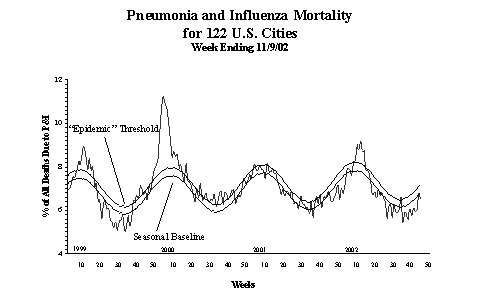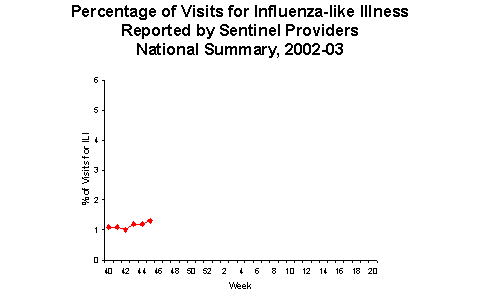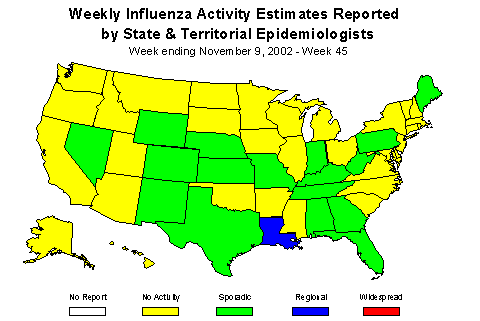Error processing SSI file
Error processing SSI file
Weekly Report: Influenza Summary Update
Week ending November 9, 2002-Week 45
Error processing SSI fileThe following information may be quoted:
Synopsis:
During week 45 (November 3-9, 2002)*, one of the specimens tested by World Health Organization (WHO) and National Respiratory and Enteric Virus Surveillance System (NREVSS) laboratories was positive for influenza. The proportion of patient visits to sentinel providers for influenza-like illness (ILI) overall was 1.3%, which is less than the national baseline of 1.9%. The proportion of deaths attributed to pneumonia and influenza was 6.5%. One state and territorial health department reported regional influenza activity, 17 reported sporadic activity, and 32 reported no influenza activity**.
Laboratory Surveillance*:
During week 45, WHO and NREVSS
laboratories reported 738 specimens tested for influenza
viruses. One influenza B isolate was identified.
Since September 29, WHO and NREVSS laboratories have tested
a total of 6,493 specimens for influenza viruses and 11 (0.2%)
were positive. Of the 11 isolates identified, 7 were influenza
A viruses and 4 were influenza B viruses. Four of the 7 influenza
A isolates have been subtyped and all were influenza A (H1?
viruses. Influenza A isolates have been identified in Florida, Louisiana, New
York, North Carolina, and South Carolina. Influenza B isolates have been identified
in New York, South Carolina, and Texas.

Antigenic Characterization of Viral Isolates:
CDC has antigenically characterized one influenza A (H1N2) virus collected from U.S. laboratories since September 29. This virus was isolated from a patient specimen collected in North Carolina in October. The hemagglutinin protein of this virus is antigenically similar to the hemagglutinin protein of the vaccine strain A/New Caledonia/20/99 (H1N1) and the neuraminidase protein is similar to the neuraminidase protein of the vaccine strain A/Panama/2007/99; therefore, the 2002-03 vaccine should provide protection against A (H1N2) viruses. During the 2001-02 season, influenza A (H1N2) viruses were isolated from several countries, including the United States. These viruses resulted from gene reassortment among the circulating influenza A (H1N1) and A (H3N2) viruses. No information suggests that A (H1N2) viruses cause more severe illness than other influenza A viruses.
Click here for more information about influenza A (H1N2) viruses
Pneumonia and Influenza (P&I) Mortality Surveillance:
During
week 45, the percentage of all deaths due to pneumonia
and influenza as reported by the vital statistics offices
of 122 U.S. cities was 6.5%. This percentage is below the
epidemic threshold of 7.2% for week 45.

Influenza-like Illness Surveillance *:
During week 45, 1.3% of patient visits to U.S. sentinel providers were due to ILI. This percentage is less than the national baseline of 1.9%. On a regional level***, the percentage of visits for ILI ranged from 0.5% to 1.8%. Due to wide variability in regional level data, it is not appropriate to apply the national baseline to regional level data.

Influenza Activity as Assessed by State and Territorial Epidemiologists**:
Influenza activity was reported as regional in Louisiana and sporadic in 17 states (Alabama, Colorado, Florida, Georgia, Indiana, Kansas, Kentucky, Maine, Missouri, Nebraska, Nevada, New Mexico, Pennsylvania, Tennessee, Texas, West Virginia, and Wyoming), and Washington, D.C. Thirty-two states and New York City reported no influenza activity.

* Reporting is incomplete for this week. Numbers may change
as more reports are received.
** Influenza activity is defined as influenza-like illness and/or culture-confirmed
influenza.
咺ncludes both the A (H1N1) and A (H1N2) influenza virus subtypes. The influenza
A (H1N2) strain appears to have resulted from the reassortment of the genes of
currently circulating influenza A (H1N1) and A (H3N2) subtypes. Because the hemagglutinin
proteins of the A (H1N2) viruses are similar to those of the currently circulating
A (H1N1) viruses and the neuraminidase proteins are similar to those of the currently
circulating A (H3N2) viruses, the 2002-03 influenza vaccine should provide protection
against A (H1N2) viruses.
*** Surveillance Regions: New England (Connecticut, Maine,
Massachusetts, New Hampshire, Vermont, Rhode Island); Mid-Atlantic (New
Jersey, New York City, Pennsylvania, Upstate New York); East North
Central (Illinois, Indiana, Michigan, Ohio, Wisconsin); West
North Central (Iowa, Kansas, Minnesota, Missouri, Nebraska, North
Dakota, South Dakota); South Atlantic (Delaware, Florida,
Georgia, Maryland, North Carolina, South Carolina, Virginia, Washington, D.C.,
West Virginia); East South Central (Alabama, Kentucky, Mississippi,
Tennessee); West South Central (Arkansas, Louisiana, Oklahoma,
Texas); Mountain (Arizona, Colorado, Idaho, Montana, Nevada,
New Mexico, Utah, Wyoming); Pacific (Alaska, California, Hawaii,
Oregon, Washington)
Report prepared November 14, 2002
Error processing SSI file